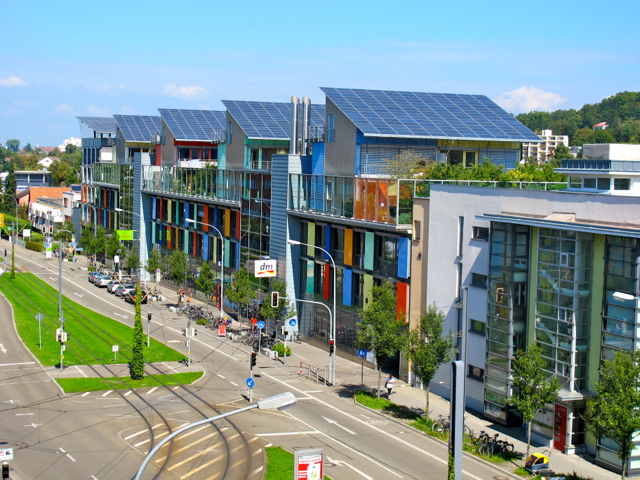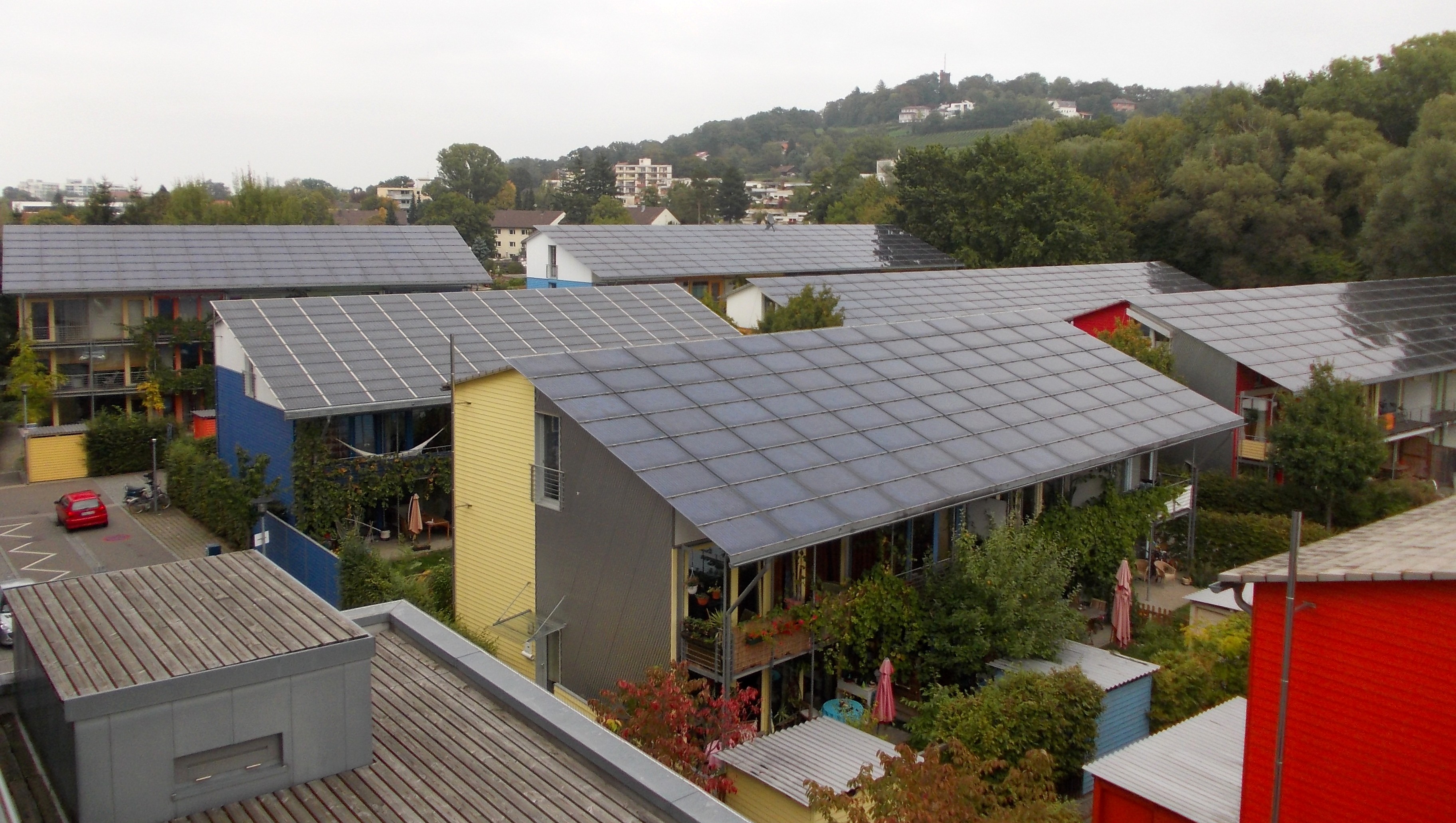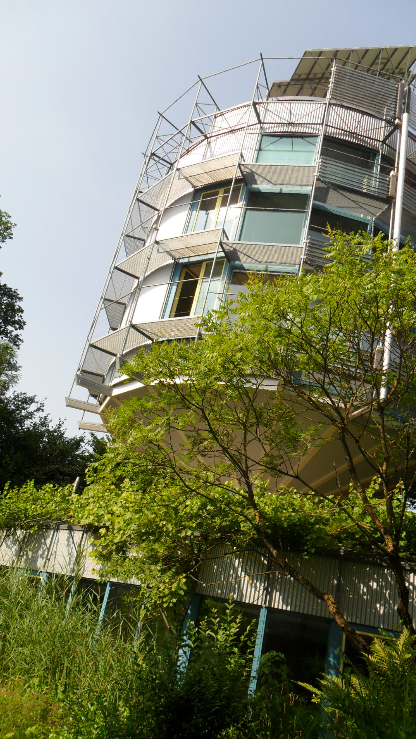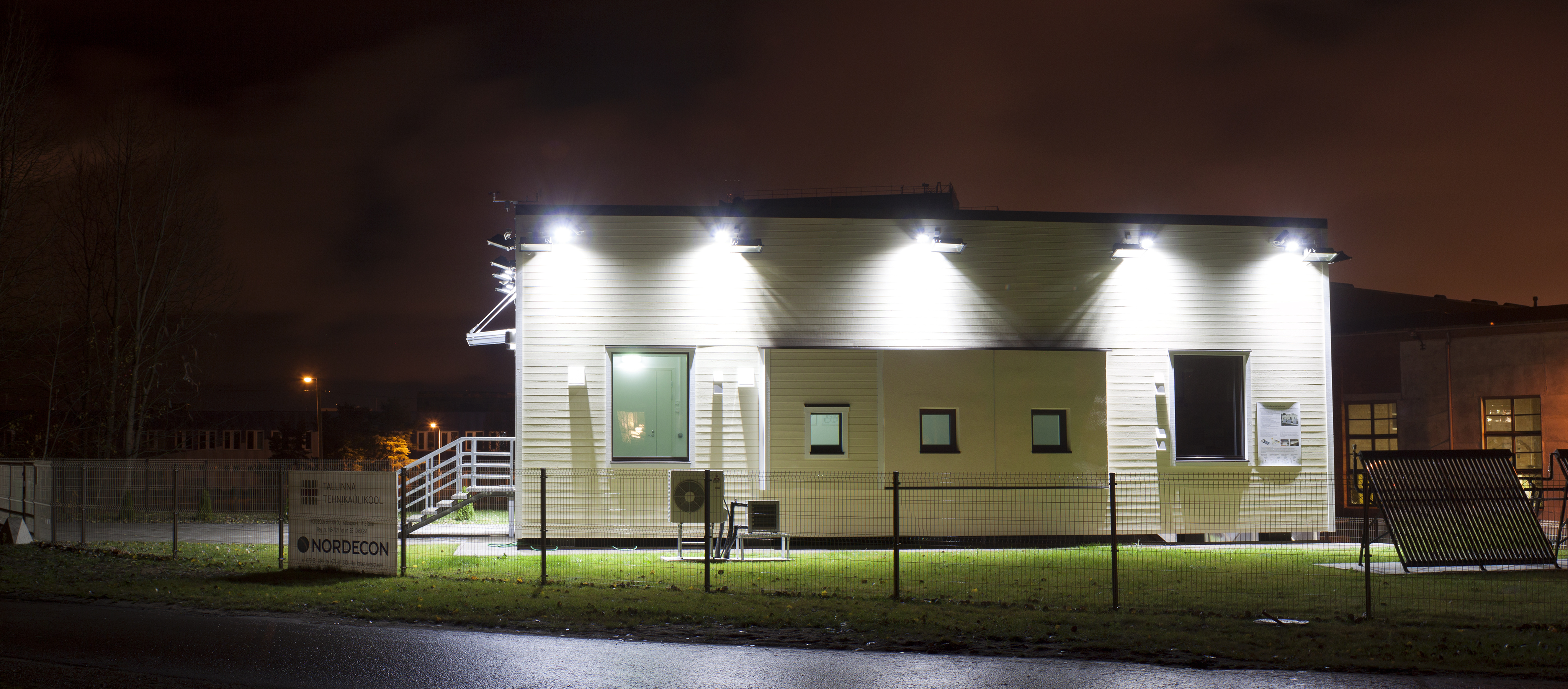|
Sonnenschiff
''Sonnenschiff'' () is a large integrated office and retail building in Freiburg im Breisgau, Germany. It was built in 2004 in the city's Vauban quarter as part of the Solar Settlement at Schlierberg. Sonnenschiff was designed by the architect Rolf Disch (who also built the Heliotrope building) and generates four times more energy than it uses. As a whole this building produces more energy than it consumes per year and utilizes the most up-to-date building technology. Some aspects that make this building particular are its vacuum insulated walls, ventilation with 95% heat recovery, triple paned windows and its energy façade. It is the first positive energy office building worldwide. The office spaces are flanked on both the East and West sides entirely with windows, which maximizes natural lighting and employee views while it minimizes the energy used for artificial lighting. Sonnenschiff includes a supermarket, convenience store and bakery-café on the first floor, offices ... [...More Info...] [...Related Items...] OR: [Wikipedia] [Google] [Baidu] |
Heliotrope (building)
The Heliotrope is a design of environmentally friendly housing by German architect Rolf Disch. Three such buildings exist in Germany; the first experimental version was built in 1994 as the architect's home in Freiburg im Breisgau, while the other two were used as exhibition buildings for the Hansgrohe company in Offenburg and a dentist's lab in Hilpoltstein in Bavaria. Several different energy generation modules are used in the building including a dual-axis solar photovoltaic tracking panel, a geothermal heat exchanger, a combined heat and power unit (CHP) and solar-thermal balcony railings to provide heat and warm water. These innovations along with the favorable insulation of the residence allows the Heliotrope to capture anywhere between four and six times its energy usage depending on the time of year. The Heliotrope is also fitted with a grey-water cleansing system and built-in natural waste composting. At the same time that Freiburg ’s Heliotrope was built, Hans ... [...More Info...] [...Related Items...] OR: [Wikipedia] [Google] [Baidu] |
Öko-Institut
The Öko-Institut (Institute for Applied Ecology) (sometimes spelled Oeko-Institut) is a non-profit, private-sector environmental research institute with its head office in Freiburg im Breisgau, Germany Germany,, officially the Federal Republic of Germany, is a country in Central Europe. It is the second most populous country in Europe after Russia, and the most populous member state of the European Union. Germany is situated betwee .... References External links * http://www.oeko.de {{DEFAULTSORT:Oko-Institut Climate change organizations Energy policy Environmental organisations based in Germany Freiburg im Breisgau Renewable energy organizations Sustainability organizations ... [...More Info...] [...Related Items...] OR: [Wikipedia] [Google] [Baidu] |
Sustainable Architecture
Sustainable architecture is architecture that seeks to minimize the negative environmental impact of buildings through improved efficiency and moderation in the use of materials, energy, development space and the ecosystem at large. Sustainable architecture uses a conscious approach to energy and ecological conservation in the design of the built environment. The idea of sustainability, or ecological design, is to ensure that our use of presently available resources does not end up having detrimental effects to our collective well-being or making it impossible to obtain resources for other applications in the long run. Background Shift from narrow to broader approach The term "sustainability" in relation to architecture has so far been mostly considered through the lens of building technology and its transformations. Going beyond the technical sphere of " green design", invention and expertise, some scholars are starting to position architecture within a much broader cultur ... [...More Info...] [...Related Items...] OR: [Wikipedia] [Google] [Baidu] |
Sustainable Building
Green building (also known as green construction or sustainable building) refers to both a structure and the application of processes that are environmentally responsible and resource-efficient throughout a building's life-cycle: from planning to design, construction, operation, maintenance, renovation, and demolition. This requires close cooperation of the contractor, the architects, the engineers, and the client at all project stages.Yan Ji and Stellios Plainiotis (2006): Design for Sustainability. Beijing: China Architecture and Building Press. The Green Building practice expands and complements the classical building design concerns of economy, utility, durability, and comfort. Green building also refers to saving resources to the maximum extent, including energy saving, land saving, water saving, material saving, etc., during the whole life cycle of the building, protecting the environment and reducing pollution, providing people with healthy, comfortable and efficient u ... [...More Info...] [...Related Items...] OR: [Wikipedia] [Google] [Baidu] |
Solar Design
In passive solar building design, windows, walls, and floors are made to collect, store, reflect, and distribute solar energy, in the form of heat in the winter and reject solar heat in the summer. This is called passive solar design because, unlike active solar heating systems, it does not involve the use of mechanical and electrical devices. The key to designing a passive solar building is to best take advantage of the local climate performing an accurate site analysis. Elements to be considered include window placement and size, and glazing type, thermal insulation, thermal mass, and shading. Passive solar design techniques can be applied most easily to new buildings, but existing buildings can be adapted or "retrofitted". Passive energy gain ''Passive solar'' technologies use sunlight without active mechanical systems (as contrasted to ''active solar'', which uses thermal collectors). Such technologies convert sunlight into usable heat (in water, air, and thermal mass), cau ... [...More Info...] [...Related Items...] OR: [Wikipedia] [Google] [Baidu] |
Solar Architecture
Solar architecture is an architectural approach that takes in account the Sun to harness clean and renewable solar power. It is related to the fields of optics, thermics, electronics and materials science. Both active and passive solar housing skills are involved in solar architecture. The use of flexible thin-film photovoltaic modules provides fluid integration with steel roofing profiles, enhancing the building's design. Orienting a building to the Sun, selecting materials with favorable thermal mass or light dispersing properties, and designing spaces that naturally circulate air also constitute solar architecture. Initial development of solar architecture has been limited by the rigidity and weight of standard solar power panels. The continued development of photovoltaic (PV) thin film solar has provided a lightweight yet robust vehicle to harness solar energy to reduce a building's impact on the environment. History The idea of passive solar building design first app ... [...More Info...] [...Related Items...] OR: [Wikipedia] [Google] [Baidu] |
Buildings And Structures In Freiburg Im Breisgau
A building, or edifice, is an enclosed structure with a roof and walls standing more or less permanently in one place, such as a house or factory (although there's also portable buildings). Buildings come in a variety of sizes, shapes, and functions, and have been adapted throughout history for a wide number of factors, from building materials available, to weather conditions, land prices, ground conditions, specific uses, prestige, and aesthetic reasons. To better understand the term ''building'' compare the list of nonbuilding structures. Buildings serve several societal needs – primarily as shelter from weather, security, living space, privacy, to store belongings, and to comfortably live and work. A building as a shelter represents a physical division of the human habitat (a place of comfort and safety) and the ''outside'' (a place that at times may be harsh and harmful). Ever since the first cave paintings, buildings have also become objects or canvasses of much artistic ... [...More Info...] [...Related Items...] OR: [Wikipedia] [Google] [Baidu] |
Freiburg (region)
Freiburg is one of the four Regierungsbezirke of Baden-Württemberg, Germany, located in the south-west of the country. It covers the Black Forest (''Schwarzwald'') hills as well as the Rhine ), Surselva, Graubünden, Switzerland , source1_coordinates= , source1_elevation = , source2 = Rein Posteriur/Hinterrhein , source2_location = Paradies Glacier, Graubünden, Switzerland , source2_coordinates= , source ... valley. It is sub-divided into the three regions (''Regionalverband'') Hochrhein-Bodensee, Schwarzwald-Baar-Heuberg and Südlicher Oberrhein. Economy The Gross domestic product (GDP) of the region was 86.9 billion € in 2018, accounting for 2.6% of German economic output. GDP per capita adjusted for purchasing power was €35,300 or 117% of the EU27 average in the same year. The GDP per employee was 97% of the EU average. References External links * {{Authority control Geography of Baden-Württemberg Government regions of ... [...More Info...] [...Related Items...] OR: [Wikipedia] [Google] [Baidu] |
Zero-energy Building
A Zero Energy Building (ZEB), also known as a Net Zero Energy (NZE) building, is a building with net zero energy consumption, meaning the total amount of energy used by the building on an annual basis is equal to the amount of renewable energy created on the site or in other definitions by renewable energy sources offsite, using technology such as heat pumps, high efficiency windows and insulation, and solar panels. The goal is that these buildings contribute less overall greenhouse gas to the atmosphere during operations than similar non-ZNE buildings. They do at times consume non-renewable energy and produce greenhouse gases, but at other times reduce energy consumption and greenhouse gas production elsewhere by the same amount. The development of zero-energy buildings is encouraged by the desire to have less of an impact on the environment, and by tax breaks and savings on energy costs that make zero-energy buildings financially viable. Terminology tends to vary between co ... [...More Info...] [...Related Items...] OR: [Wikipedia] [Google] [Baidu] |
Green Building
Green building (also known as green construction or sustainable building) refers to both a structure and the application of processes that are environmentally responsible and resource-efficient throughout a building's life-cycle: from planning to design, construction, operation, maintenance, renovation, and demolition. This requires close cooperation of the contractor, the architects, the engineers, and the client at all project stages.Yan Ji and Stellios Plainiotis (2006): Design for Sustainability. Beijing: China Architecture and Building Press. The Green Building practice expands and complements the classical building design concerns of economy, utility, durability, and comfort. Green building also refers to saving resources to the maximum extent, including energy saving, land saving, water saving, material saving, etc., during the whole life cycle of the building, protecting the environment and reducing pollution, providing people with healthy, comfortable and efficient u ... [...More Info...] [...Related Items...] OR: [Wikipedia] [Google] [Baidu] |
Anti-nuclear Movement In Germany
The anti-nuclear movement in Germany has a long history dating back to the early 1970s when large demonstrations prevented the construction of a nuclear plant at Wyhl. The Wyhl protests were an example of a local community challenging the nuclear industry through a strategy of direct action and civil disobedience. Police were accused of using unnecessarily violent means. Anti-nuclear success at Wyhl inspired nuclear opposition throughout Germany, in other parts of Europe, and in North America. A few years later protests raised against the NATO Double-Track Decision in Germany and were followed by the foundation of the Green party. In 1986, large parts of Germany were covered with radioactive contamination from the Chernobyl disaster and Germans went to great lengths to deal with the contamination. Germany's anti-nuclear stance was strengthened. From the mid-1990s onwards, anti-nuclear protests were primarily directed against transports of radioactive waste in "CASTOR" cont ... [...More Info...] [...Related Items...] OR: [Wikipedia] [Google] [Baidu] |








